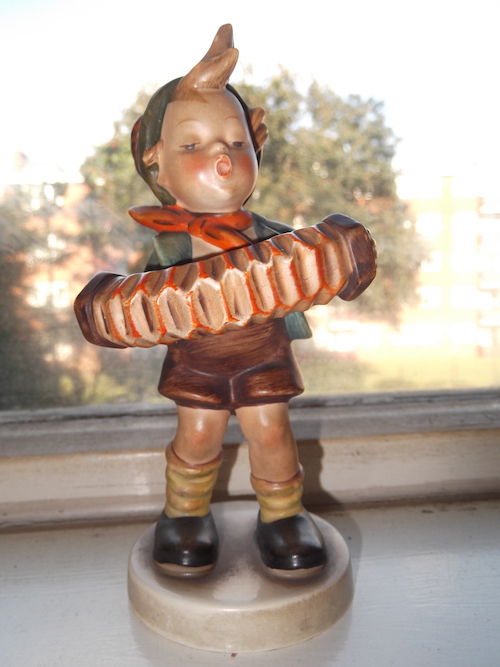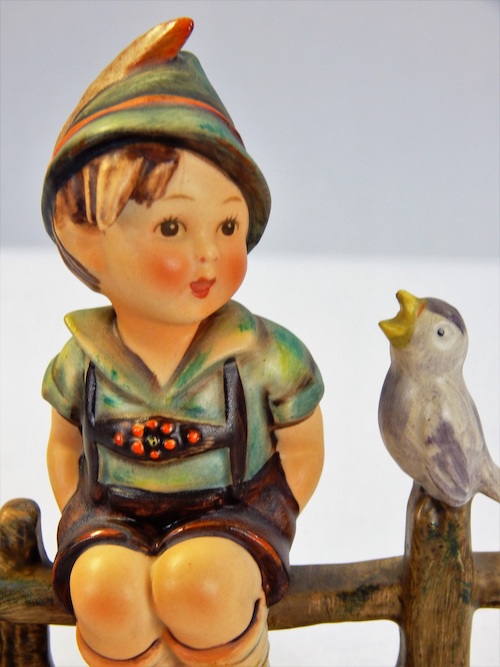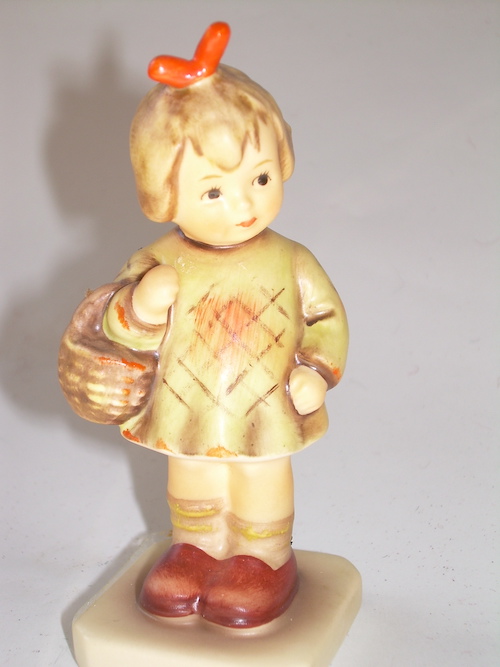
You’ve probably seen a Hummel figurine atop somebody’s fireplace—a sweet child reading a book, playing music, or going about their daily task. These porcelain figurines embody the simple beauty of the early 20th century Bavarian countryside.
With their soothing pastel colors and adorable characters, the figurines amassed millions of Hummel collectors to this day.
While most Hummels go for $50, some of them are worth a few hundred dollars, and rare Hummels can sell for up to 5-figures during auctions.
If you have a Hummel figurine, but you’re not sure what it’s worth, stick around. It might be a hidden gem.
Conceived by Sister Maria Innocentia Hummel—a prolific German artist and Franciscan nun—the first figurines were produced by Franz Goebel in 1935.
Except for a few short breaks during World War II and in the early 2000s, the figurines have been in continuous production, breathing life into hundreds of M.I Hummel’s drawings.
Born in 1909 in Massing, Germany, Berta Hummel was encouraged by her parents to develop her artistic talent. When speaking of her creative insight, her mother, Victoria Hummel, said “… a bunch of pretty flowers, a pleasing child’s face, a beautiful evening mood, an autumnal forest. All these things could delight her and she would stand and look and look, for what seemed like an eternity.”
After graduating with honors from the State School of Applied Arts in Munich in 1931, Berta joined the Franciscan Sisters of Siessen, where she was given the name of Maria Innocentia.
It was at the convent that sister Hummel started drawing sweet children with rosy cheeks performing daily tasks. The drawings represented her childhood in Bavaria—scenes of innocence and sincerity.
In the early 1930s, Hummel’s drawings were published as postcards by Munich-based publisher Ars Sacra. They soon caught the eye of Franz Goebel—master porcelain maker and owner of the W. Goebel Porzellanfabrik.
Goebel decided to render Hummel’s drawings as porcelain figurines. After initial resistance, M.I. Hummel agreed, reserving the right to choose the official color palette and approve every single figurine.
After Hummel’s death in 1946, this right was transferred to an Artistic Board of the Sisters of Siessen, who continue to closely guard Hummel’s philosophy and artistic style to this day.
Goebel produced the first Hummel figurines in 1935 and production continues until this day. Each one goes through a long, painstaking process involving multiple artisan sculptors, master mold makers, and painters.
The Goebel company carefully controls the production process in order to ensure that a Hummel figurine made in 2010 is exactly the same as one made in 1950. Here’s a brief overview of the process:
First, an artwork of Maria Innocentia Hummel was selected for the new figurine. She was so prolific in her drawings, new figurines continued to be produced long after her death.
A master sculptor then created a clay figurine from the drawing, spending weeks perfecting the shapes, lines, and features in an effort to stay as close to Hummel’s work as possible. Once the sculpture was approved, a master model was made.
From the master, copies were produced, molding numerous figurine parts using liquid ceramic. Complex figurines are made from up to 40 individual pieces, which are molded separately and joined later.
After the figurines are assembled, they’re fired three times in a kiln, glazed, and fired once more. The glazed blanks are finely painted using a palette of more than 200 colors, all handpicked by Maria Innocentia Hummel way back in the 1930s.
The process to render the drawing into a completed porcelain figurine could take months and each step received the approval of the Sisters of Siessen. With all the work that goes into making these figurines, it’s no wonder that they’re so highly prized.
When the Nazi regime came into power, all religious schools, including the Sisters of Siessen, were closed down. M.I.
Hummel was personally attacked for her art. The Hummel figurines were banned in Germany and Goebel was forced to cease production.

By that time, Dr. Herbert Dubler and Ars Sacra had already established a New York-based distribution company. Dubler brought a number of Hummel’s products from Germany into the United States market—postcards, folders, and later figurines.
In 1940, Germany stopped sending products for Dubler to sell. Faced with huge demand, Dubler decided to create new products that closely followed the original art of M.I Hummel but were designed and manufactured in New York.
Thus the Dubler figurines were born. There may be as many as 50 different figurines produced by Herbert Dubler Inc. These figurines are made out of plaster-like material and usually feature a copyright date, “B. Hummel” and either “Herbert Dubler, Inc.” or “Ars Sacra” incised onto the base of the figurines.
Because Ars Sacra was the first company to publish M.I. Hummel’s work (the initial postcards) and held copyrights to her art, many consider the Dubler figurines as legitimate collector pieces.
But Herbert Dubler wasn’t the only one to go after the market gap left by Goebel during World War II.
As many as twelve different figurines exist with a back stamp of “Beswick – England”—a well-known porcelain manufacturer. These are usually marked with mold numbers 903 to 914.
However, when the Beswick company was later bought, no documentation, molds, or references for the Hummel figurines were discovered.
This is where history ends. Nobody can prove who really produced the Beswick figurines, but this is the magic of the collector market. Speculation and mystery always bear a good price.
Thus today, both the Dubler figurines and the Beswick figurines are much sought after collector items, even though they are not “authentic” Hummel figurines.
M.I. Hummel’s enticing designs made for lots of copycats, imitations, and pieces inspired by her drawings. In addition to the pieces made during World War II, Asian manufacturers have flooded the market with copies and reproductions, which are worth considerably less.
So, how can you tell if you have an authentic Hummel or merely a copycat?
The first thing you need to do is look for the Goebel trademark, also known as a TMK, at the bottom of your Hummel figurine.
Each Goebel-produced figurine is stamped with the company logo. Different logos were used in different periods, which makes it easy to identify how old your Hummel is.
Goebel first started with TMK-1 (oldest) and moved all the way through TMK-8 (newest). Suffice to say, if you have a TMK-2 or a TMK-3, your Hummel is older and worth more.
As you can see in the picture above, it’s easy to identify the shape and style of the bee and V symbols. A full bee is typically depicted in older models, and the image pays homage to Hummel, whose name means “bumblebee” in German.
Larger figurines and those with a base also received M.I. Hummel’s signature.
Each figurine has the so-called Hummel or HUM number. It’s a 1 – 4 digit number that identifies its model. For example, Adventure Bound is #347. Figurines produced in different sizes, also have designators appended to the HUM.
These numbers are usually cast with the figurine or incised in the soft porcelain, so they are a permanent identification feature. Cross-referencing the HUM number online will easily tell you the name of the figurine and give you additional information about it.
Other markings you can find on authentic Hummel figurines are:
It’s very easy to tell a forgery from an authentic Hummel figurine if you put them side by side and know what to look for. In addition to carrying the unique style and proportions of Maria Innocentia’s original drawings as well as its TMK mark and identification symbols, be on the lookout for the following when trying to decipher if your Hummel is authentic or not:
The fake figurine might have missing, added, or displaced features. For example, the head is turned to the other side, the facial expression is different, or a patch of grass is missing.
If you can, compare your figurine to a verified original, to ensure their features are the same.
Forgeries often weigh less than real Hummel figurines. The Goebel company uses a specific porcelain mix which makes the final product feel rather solid. Copies frequently use cheaper materials like chalk, plaster, or even plastic.
If your figurine is made out of plastic, it’s not a genuine Hummel.
Finally, real Goebel-made Hummels use a specific color palette defined by Maria Innocentia herself. Fake Hummels are usually colored similarly, but not quite the same, making it easy to spot a reproduction.
Look for any odd hues and shades on your figurine. If you can, reference the colors of a verified Hummel. It doesn’t need to be exactly the same figurines. The color palette can be recognized across genuine Hummel figurines.
Most Hummel figurines are worth $50-$75. Some models reach several hundred dollars. Special individual Hummel figurines can be sold for thousands and even tens of thousands of dollars. For a good starting point, reference this Hummel Figurine Guide, but note that prices can vary widely depending on certain factors.
Here are some of the most valuable Hummel figurines on the market. Bigger models tend to be valued at higher prices.

One of the most popular Hummel figurines is “Adventure Bound.” The scene depicts six characters, equipped with a large spear and a lantern, venturing into the world.
A boy or a girl figurine sitting on an apple tree branch. These can be sold individually or as a set. Some of the early models (tmk-1, tmk-2, and tmk-3) are among the highest-priced Hummel figurines ever.
Large versions with Hummel numbers #142/X and #141/X can be valued at $26,000 or more, according to experts.
A young photographer snaps a picture of three children with their toys and dog. This is a complex scene with a number of characters and small details. Only 2,500 of these were produced, which is the main price- forming factor.
Produced for the 25th anniversary of the Hummel figurine, “Ring Around the Rosie” depicts four little girls holding hands and playing in a circle.
These figurines display a group of school boys and a group of school girls, respectively. Each figure depicts the students standing together with their school supplies.
Larger versions range from 9 ½ to 10 inches tall and are permanently retired by Goebel. This makes them extra valuable if presented in good condition.
Two children peek over a fence, watching a beautiful swan and it’ goslings.
This piece was produced in 1000 units, which makes it an extremely rare Hummel figurine. It’s even more valuable with the porcelain identification plaque, which came with the original figurines.
Once you’re sure of the type, authenticity, and you have a ballpark of it’s worth, it’s time to make some cash. Here are the most popular ways you can sell your Hummel figurines:

A good way to liquidate the value of your Hummel figurine is to sell it at an auction. Most auction companies organize collectible auctions, advertised to networks of knowledgeable collectors and traders.
There is a good chance to sell your valuable Hummel figurines at a fair price, though you never know with auctions.
If the Hummel figurines are part of an estate that you inherited or need to clear, consider organizing an estate sale. If advertised properly, the Hummel figurines can be the main selling point of the event and attract collectors who might buy other items as well.
With an estate sale, you set the price so you can ensure they will sell at fair market value. That said, you should be wary of who appraises your collection of Hummel figurines. It’s easy to underprice one, since even minuscule details can dramatically change the price.
Of course, the most obvious options to consider are popular online marketplaces, like Craigslist and eBay. While these websites get millions of visitors every day, buyers are often looking for cheap deals and may not be collectors willing to pay what your figurine is worth.
There are more specialized websites focusing on antiques and collectibles of value, like Ruby Lane. This website is popular among serious collectors and professional art and antiques traders. While it receives less traffic, visitors are more targeted and likely to treat your Hummel figurines appropriately.
Hopefully, this article has been a good introduction to the world of M.I. Hummel and her darling figurines. Her legacy and vision of the pastoral German countryside will live on through the Hummel figurines.
This guide can help you identify your Hummel figurine and it’s worth, however, it’s not exhaustive. If you believe you have an extraordinary example, it’s best to contact experts in antiques and collectibles.
True Legacy Homes can help you identify and appraise Hummel figurines and other valuable items in your estate.
SAN DIEGO
3635 Ruffin Rd, Suite 100
San Diego, CA 92123
IRVINE
15375 Barranca Parkway, Suite A-107
Irvine, CA 92618